

Having Fun With Nature
Growing Herbs
Tips
| Vegetables | Recipes | Flowers | Roses | Propagation | Landscaping |
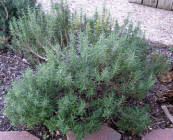

Why grow herbs when the grocery store has both fresh and dried herbs? If you take an urge to put some fresh mint in your iced tea, add tarragon to a fish dish, or garnish a vegetable with thyme and parsley-that urge can be satisfied by your own herb garden just outside your door (or inside your door if you do container gardening).
Besides growing herbs for immediate use, you can dry or freeze your excess for winter use. Very few herbs don't either dry or freeze well. Having an herb garden, no matter how small, is fun, money-saving, and full of great scents and tastes
If you grow Parsley , let it be the flat-leaf Italian variety which is much tastier than the curled parsley.
Rosemary is a strong-scented, strong flavored herb, but it's one of our favorites (Rosemary potatoes!). You can also use the larger rosemary branches as skewers for grilling chicken pieces. Just strip off the rosemary and the branches infuse the chicken with a gentle flavor.
Thyme is a must-have in the herb garden. There are lemon thymes, winter thyme (which really has nothing to do with the season), broad-leaf thyme, lots of thyme!
Sage is also needed in the well-furnished herb garden, and it's pretty, too.
Chives , both onion (round leaves) and garlic (flat leaves) are wonderful used fresh since chives just don't cook well.
There is nothing better than having culinary herbs as close to the kitchen door as you can manage. Human nature being what it is, nearby herbs get used and enjoyed more than ones that require a trip to the farthest part of the yard!
Herbs in containers usually do well, if the herb doesn't have a long tap root (like dill) or gets really large (like African basil or a bay laurel tree). Basil, oregano, thyme, chives, parsley, and most definitely mints do well in containers.
It is best to put only one herb per container, since the moisture and fertilizer requirements may differ dramatically. Yes, we said don't fertilize herbs, but in a container the essential nutrients are used up or leach out faster, so a little fertilizer judiciously applied is appreciated by the plant.
Interested in herbs? Our monthly newsletter has an "Herb of the Month" discussion along with a recipe using the herb.
Just click on the subscription icon below and type "Subscribe" in the title of the email. You'll receive the most recent newsletter and all future ones.
Herb Drier

Fertilizing
If you fertilize your herbs, you will get lush foliage, big plants and very little taste. Herbs need a little adversity to develop the essential oils that provide their distinctive taste.
If you are growing an herb just for the looks of it (like the artemesias or tansy) go ahead and give an occasional feeding.
Herbs Drying on a Kitchen Beam
What herbs to grow is a matter of personal taste.
Almost everyone likes
Basil
, so it's a good choice. There are hundreds of basils, but for most people the plain Italian basil (also called Classico, Giant Leaf or Sweet Basil) is most useful.
Oregano
(either Greek or Italian) is a companion to basil, and is useful in most Italian dishes, as well as sprinkled in a salad or on cooked green beans.

Location, Location, Location
Plant herbs "in the sun with good drainage." Most herbs prefer a lean soil with good drainage, and a goodly amount of sun.
"Full sun" in the Northeast is different from "full sun" here in Texas. Our herbs get morning sun which dries dew off the leaves, and mid-afternoon shade, which keeps them from cooking in our heat! If your herb garden gets some shade, afternoon shade is preferable.
Starting Herbs from Seed
Rosemary
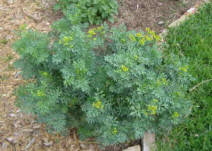

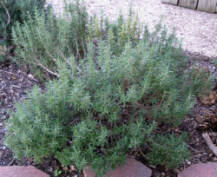

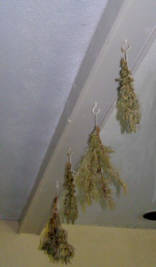

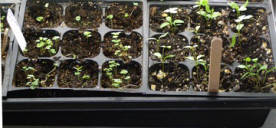

Annual herbs can be planted where you like, since they will be there for a short time (basil, dill, cilantro are common annuals), and can even be in a flower bed or vegetable garden.
Perennial herbs , like rosemary, oregano, chives, and sage don't like to be moved, so plant them where they can stay for a long while. Mint, while it is perennial, is also invasive, so it is best kept in a container. You can sink the container in the ground, leaving about 2" of pot rim exposed to keep the mint from crawling. However, be vigilant because mint will go up and over the rim, or send roots out into the surrounding countryside if its container is shallow. Mint will also take more shade than most herbs, so you can put it in a spot where most herbs and many flowers wouldn't thrive.
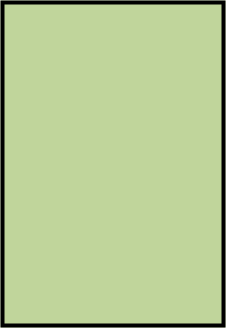
Harvesting
Harvesting should be done early in the morning, as soon as the dew is off but before the sun is on the plant very long. The essential oils that give flavor are strongest at this time. A pair of small, sharp scissors work well for cutting stems. When you cut a stem, make the cut just above a leaf node to encourage bushing.
Take as much as ⅓ of the plant at a time, especially if you are going to freeze or dry the excess. Herbs that are not harvested regularly grow into leggy, lank plants.
Copyright © Red Gate Farm 2012. All rights reserved.
Freezing
is the best method to preserve basil and parsley. Neither keep their characteristic flavor when dried. Chop the fresh herb fine, add enough water to make a slurry, and put into ice cube trays. When frozen, transfer to another container and pull out the 1 tblsp. equivalent of a fresh herb.
Drying
is a good method of preserving leafed herbs such as oregano, sage, and rosemary. Just cut long stems, tie the cut ends together in bunches of four to six stems, and hang where the bunches are out of direct sunlight but have good air circulation and no steam or moisture!
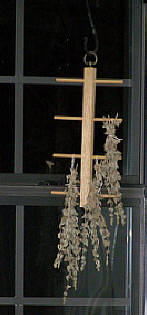

Rue
